Td SUMMER SCHOOL 2018 in Lüneburg, Germany 渡航ならびに参加報告書
報告者 佐藤 賢一 京都産業大学総合生命科学部
渡航期間: 2018年9月2日(日)〜8日(土)
渡航先 : Lüneburg, Germany
用務名称: TD Training Module 2018
開催場所: Leuphana University 参加人数: 31名
このたび、ドイツのリューネブルクにあるLeuphana大学メソドロジーセンターが主催す る Td サマースクール 2018(以下、サマースクール)に参加する機会をいただきました。 本サマースクールは、9/2〜7 に Td トレーニング・モデュール(TD/超学際研究の理論と ケーススタディなど)、9/10〜11 にスペシャル・トレーニング・モデュール(TD/超学際 研究のデザインプロセスの理論と実践など)を行う二段階構成からなり、さらにはサイド イベントとして9/11〜13にアジェンダ・セッティング・ワークショップをおこなうという 約2週間がかりの内容豊かなプログラムを提供するものです。わたしはTdトレーニング・ モデュールの4日間(9/3〜6)に参加してきました。
TD/超学際研究とは何かという理論的なことはもちろん 、講師陣を含む参加者同士の親密さを促す関係作りに工夫を凝らしたプログラム作り(創発性にくわえてHostingを意識したワークショップ)、さらにはその工夫があってこそのじっくりと時間をかけてのケーススタディワーク(チーム 単位の自由作業、講師陣による随時コーチング)、これらが一体となって実に学びの多いサマースクールでした。持ち帰ることができたのは、コンテンツ(プログラムデザイン、講義内容・参考資料・論文・図書など)と実践経験(ケーススタディ)、そして何よりも講師陣と参加者とのネットワークです。これらをぜひOpenTSプロジェクトの推進はもとより、日本におけるTD/超学際研究の振興に役立てられるよう共有、発信、ならびに活用していければと願っています。
サマースクールのコンテンツの中でも特に、後半部のチーム単位でのケーススタディをおこなうにあたって指南書として共有された資料「The Case」は非常に興味深いものでした。ここにはケーススタディを行うにあたってのステップが20項目示されています。それぞれの項目はガイドのための質問、タスク、コメントおよび所要時間から構成されています。特にガイドのための質問は、ステップ1:どんなケースか?から始まり、20のケーススタディ過程がどのような問いの連続により成り立つのかという構造を理解するためにとても有用かつ刺激となるものでした。
Programme Overview – Td Training Module 2018
| Monday, 3/9/2018 | Tuesday, 4/9/2018 | Wednesday, 5/9/2018 | Thursday, 6/9/2018 | Friday, 7/9/2018 | |
| 9:00-12:30 | ntroduction: Historical, cultural backgrounds and current need for Td research |
Introduction Td research methodology: dimensions, principles, phases, knowledge |
Methods for Td research II: mutual learning and re-integration |
The Case: joint development of a Td case study design | The Case: joint development of a Td case study design |
| 13:30-18:00 | Exchange on professional activities of participants at the science | society interface Sorting out concepts: inter-, multi-, pluri-, trans & positioning Td |
Methods for Td research I: overview, problem framing, knowledge integration, visioning, experiencing the field, | The Case: joint development of a Td case study design | The Case: joint development of a Td case study design
|
Presentation of case study designs Feedback, Evaluation of Summer School and Outlook |
| Evening | After work-walk | Presentation of UNESCO-Chair activities |
City Tour & dinner at the local brewery | Fading out… |
日報
2018.09.03 AM
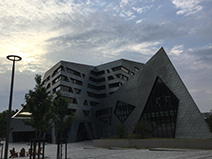 サマースクール冒頭に、私ともう1名の遅刻組からの自己紹介が求められました。その後、講師の自己紹介トークが5名からありました。続いて、オーガナイザー役の ULLI さんからのイントロダクション講義は、TD を「境界 BOUNDARY とは何か」と「変化/変革 TRANSFORMATIONのレベル」の主に2点から解説するものでした。
サマースクール冒頭に、私ともう1名の遅刻組からの自己紹介が求められました。その後、講師の自己紹介トークが5名からありました。続いて、オーガナイザー役の ULLI さんからのイントロダクション講義は、TD を「境界 BOUNDARY とは何か」と「変化/変革 TRANSFORMATIONのレベル」の主に2点から解説するものでした。
LECTURE ON TD RESEARCH BY ULLI
Boundaries between:
・ Established disciplines/specialized fields of knowledge and action
・ Institutions that have particular roles and aims in society and established practices
・ Societal fields (e.g. economy, civil society, administrations, politics)
・ IndividulasLevel of transformation
Societal level
・ Create institutional spaces, networks for cross-sectional, joint research ・ Foster discourse on changing roles, tasks and responsibilities of societal domains, in particular the role of science in society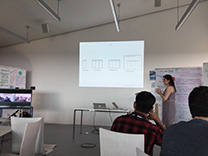 ・ Providing funding schemes for joint research, in particular for identification of research topics ⇅ Research level
・ Providing funding schemes for joint research, in particular for identification of research topics ⇅ Research level
・ Develop research frames in terms of principles and process design
・ Re-define the concept of research and methods for research
・ Develop methods for problem framing, knowledge integration and transformation
⇅
Personal level
・ Provide personal conditions for integration
・ Reflect self-concepts and concepts of others
・ (Re)frame personal-professional identities
・ Contribute with courage and openness: td is constituted in complementarity
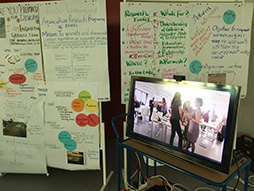 午前中の後半部は、参加者全員によるあらためての自己紹介ワークでした。模造紙とマーカーペン、可能なら写真などを使い、5分間程度で下記の4項目を記した作品を作りました。その上で3グループに分かれて、1回あたり5分程度の説明と質疑応答を3回繰り返しました。毎回必ず2名ずつ以上の聴講者がいるように、というスタッフの指示がありながらのワーク。終了後は発表する側、聴く側それぞれの立場からの簡単な振り返り(4名が挙手の上で発表)を行いました。
午前中の後半部は、参加者全員によるあらためての自己紹介ワークでした。模造紙とマーカーペン、可能なら写真などを使い、5分間程度で下記の4項目を記した作品を作りました。その上で3グループに分かれて、1回あたり5分程度の説明と質疑応答を3回繰り返しました。毎回必ず2名ずつ以上の聴講者がいるように、というスタッフの指示がありながらのワーク。終了後は発表する側、聴く側それぞれの立場からの簡単な振り返り(4名が挙手の上で発表)を行いました。
SELF-INTRODUCTION WORKSHOP
Prepare self-introduction poster that contain the following four items, in 5 min. Pasting.
5-6 min talk on poster, 3 times in one round, 3 rounds to have all presentations. Reflection after all presentations.
・ What is your field or research field? WHAT
・ What is the objective of your work? WHAT FOR
・ Where do you work? WHERE
・ Who do you work with?
2018.09.03 PM
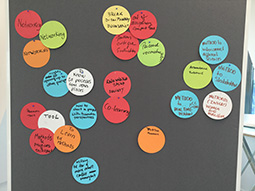 5〜6人のテーブルグループ内で、サマースクールに参加するにあたってのイシューや動機についての自己開示ワークをおこない、出てきた要素を付箋紙5枚にまとめて、スタッフがグルーピングしながら全体共通のボードに貼り付けました。スタッフが出てきた要素をレビューし、 参加者が期待すること、学びたいことが多様なようでかなり共通していることを確認共有しました。
5〜6人のテーブルグループ内で、サマースクールに参加するにあたってのイシューや動機についての自己開示ワークをおこない、出てきた要素を付箋紙5枚にまとめて、スタッフがグルーピングしながら全体共通のボードに貼り付けました。スタッフが出てきた要素をレビューし、 参加者が期待すること、学びたいことが多様なようでかなり共通していることを確認共有しました。
REVIEW OF ISSUES AND MOTIVATION OF ALL PARTICIPANTS
~3 min talk on my issues and motivation to participate td summer school, 5 persons.
Pickup issues/motivation.
Review by staff of collection of issues/motivation by all participants.
・ How to design and implement HATENATHON into societal issues?
・ How to develop my skill and experience to become PM?
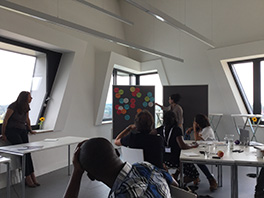 その後は3人の講師からのレクチャー(3人目は南アフリカからのオンライン講義)があ り、TDの来歴、PARとの関係、TDとは何か、といった焦点について学びました。
その後は3人の講師からのレクチャー(3人目は南アフリカからのオンライン講義)があ り、TDの来歴、PARとの関係、TDとは何か、といった焦点について学びました。
LECTURE ON TD RESEARCH
・ From in vitro to in vivo
・ The Two Cultures by Charles Parcy Snow
・ OECD 1972 conference: TD was first used
・ UN 1992 conference Rio
・ Michael Gibbons et al. 1994, 1999 in Nature
・ Manifesto of TD research by Nicolescu 1994, 2002
LECTURE ON PARTICIPATORY ACTION RESEARCH AND TDR
・ Action research, coined by Kurt Lewin
・ TDR, democracy and plural participation/integration and cocreation of knowledge via praxis/cocreation of knowledge, practices and powers for socio-environmental change/science of social practice (not neutrall)/social learning and un
certainty
・ TDPAR = TD + more involvement of naturalscience experts/critical engagement of policy makers, industry, mainstream media and arts/added attentions to power asymmetries and conflict in collaborative processs/broaden transformative changes
LECTURE ON MULTI-, INTER-, AND TRANS-DISCIPLINARITY
・ Two different images, one for TD the other for non-TD, are shown
・ My notes: TD is not individualistic, while non-TD, especially multi-D, is individualistic. In TD, the total level defines the power to achieve something, the part of which is dispensable. In non-TD, especially multi-D, each discipline is indispensable, complete lineup of which is necessary for achieving something.
LECTURE ON DESCRIPTION (NOT DEFINITION) OF TD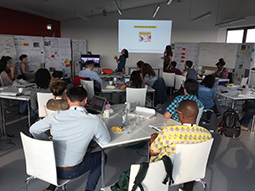 ・ TD is a new methodology, not a new science, for social change at all levels (global, meso, and micro levels)
・ TD is a new methodology, not a new science, for social change at all levels (global, meso, and micro levels)
・ Transformative TD methodology (TTDRM) confers an ability to switch between domain-relevant methodologies (methodological agility, to agile)
・ Methodology = research design and strategy-making processs
・ Contexts or domains = complex + complicated + chaos + simple
・ Cynefin framework
2018.09.04 AM
全員で輪になってのワークでスタートしました。まず目を閉じての呼吸を整え、目を開け た後、輪を小さくして全員で肩を組みました。その後のワークは以下の通り:
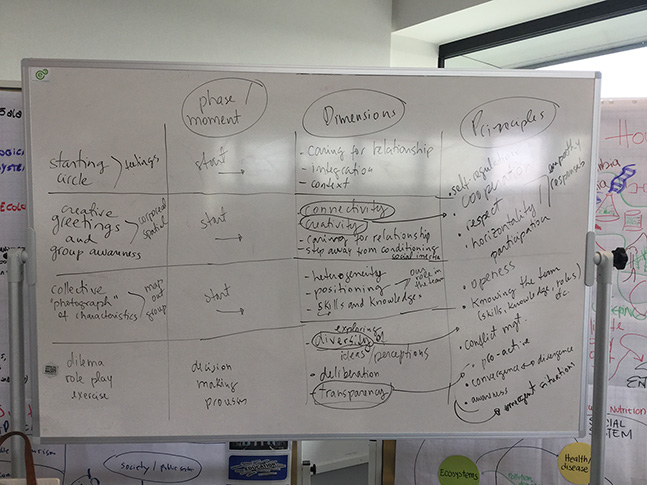
2018.09.04 PM
TALK on Case Study by JvB ホームページ
論文情報(2018 年)
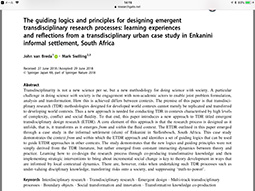
キークエスチョンを探すグループワーク@4〜5人グループ 「Did some leaders emerge by the end of the project and what role did they play?」 グループごとに代表質疑応答(一覧は以下の通り)
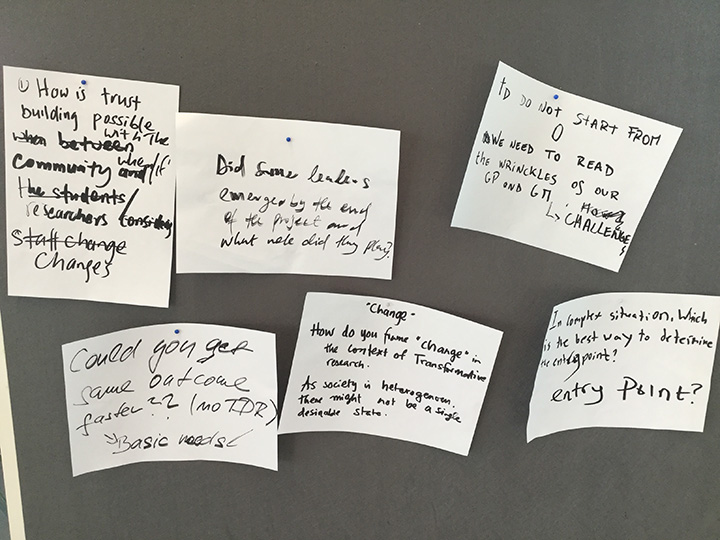
Francisco Xavier Martinez Esponda@ CEMDA, MEXICOによるonline TALK (論文情報などは配布物に記載あり)
質疑応答
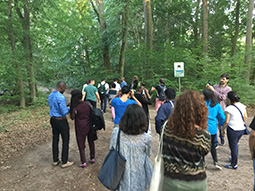 ・ 人形劇
・ 人形劇
・ 1日の学びで得られた気づきを出し合うワーク@4〜5人グループ
・ 6〜7名による発表
・ キャンパス横の森のウォーキング(〜2時間:午後7時45分まで)
18.09.05 AM
TD研究の方法論についての講義(by Ulli)
Methods for TD research
・ Quantitative methodology
・ Qualitative methodology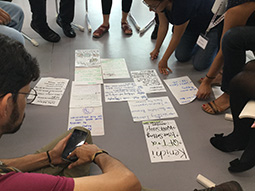 ・ Transformative methodology Other categorization
・ Transformative methodology Other categorization
・ Scientific research methods: data collection, interpretation, processing・ Corporation methods: creation of conditions for thinking and acting
・ Management methods: same as above
・ ID/TD research methods: differentiation, integration
・ (formative) evaluation methods
・ Assessment, negotiation, and mediation methods
Why Boundary-work? The followings are boundary obkectives:
・ Images
・ Symbols
・ Words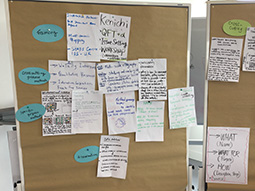 ・ Cases
・ Cases
・ Aritifacts
質疑応答
3つのグループに分かれての、各人がもつ方法論のタネだしとカテゴリ化
代表者による結果の発表と共有:共通項などに関するコメント、意見交換
18.09.05 PM
ここからいよいよケーススタディが始まりました。31名いる参加者が2〜4名の自発的に作られたグループに分かれ、どのようなケースを扱うかを決め、そして20のステップからなるTD Case Study Designワークを順番に辿りながら進めるというものです。 わたしはネパールのBadal、メキシコの Diana、ガーナの Fred との4人チームを作り、 Badalが提案した「2015 年に発生したネパール首都カトマンズでの震災」を題材にケーススタディに取り組みました。チーム名は「Disaster Resilience」としました。以下には、TD Case Study Designの20ステップの1〜4と、私たちチームの取り組み結果の一部(ステップ1〜3と4の一部)を記します。 ケーススタディは丸2日間行い、最終日の 9/7 午後にチームごとに発表するという流れでした。私は残念ながら6日までの参加でしたが、ステップ16まで進むことができある程度の方向づけを共有するところまで関わらせてもらえました。
The Case
| Step | Guiding Question(s) | Task | Comment | Min | Time |
| WEDNESDAY, 5th September | |||||
| Plenary I : Elaborating a general framework | 15’ | 14:30~16:00 | |||
| Step 1 | What is the case about? | Provide a general description of the case in non-scientific language in 4-5 sentences. | Use a (digital or flip-chart) poster for summarizing the results of step 2 to 6. | 30’ | |
| Step 2 | What is the societal challenge / problem? For whom is it a challenge / problem? |
Describe the challenge / problem and discuss it within the group. | 30’ | ||
| Step 3 | Is there a general knowledge-gap or a need for knowledge transfer to the case-context? | Distinguish whether the case is referring to a highly unknown field or if it is mainly about translating knowledge to a specific context. | Characterize the case and refer to the state-of-the -art or best practice | 15’ | |
| Coffee break | 30’ | 16:00~16:30 | |||
| Step 4 | What is the scientific relevance/ interest? | Formulate topics and questions that are of scientific concern. | Characterize the case and refer to the state-of-the -art or best practice | 30’ | |
Step 1 : Analysis of earthquake vulnerability and pathways to enhance resilience in Bhaktapur District, Nepal (Case)
Step 2: Description, challenges and problems
Bhaktapur District, one of the oldest town (13th century) and living cultural heritage in central Nepal, is an important city from perspective of tourism and ethnic Newar community and culture. Bhaktapur Durbar Square, a UNESCO listed world heritage site lies in this district. Bhaktapur was one of the most affected towns in Kathmandu valley due to Gorkha Earthquake 2015 (Gautam and Rodrigues, 2018). About 333 people were killed, 2101 people were injured, 18900 public houses were totally destroyed, nearly 9090 houses were partially collapsed and 745 monuments were collapsed due to this earthquake (Disaster Risk Reduction Portal Nepal, 2015). Apart from this destruction, food, drinking water, sanitation and security emerged as the post-earthquake disaster consequences that created the per capita disaster effect of about USD 687165.85 (Thapa et al. 2016). In addition, the collapsing of temples and cultural structures affected the tourism, aesthetic beauty and also created a huge impact in economic condition of the area. The total loss of cultural heritages is estimated to be about USD 785133.00 (Kunwar and Chand, 2016).
Step 3
The major societal challenge in Bhaktapur is that the impacts of the earthquake transcends various dimensions like socio-economic aspects, political crisis, cultural sector, health sector, physical environmental sector and so on. A mono-disciplinary approach cannot solve these problems and hence the involvement of concerned teams from various fields (for an instance social scientists, geologists, engineers, food scientists, psychological experts and others) is utmost to tackle this societal challenges.
Step 4:
The major concerned questions are:
a. How vulnerable is Bhaktapur from earthquake scenario?
i. What are the best indicators of vulnerability for each one of the dimensions (social, political, economic, and physical)?
1. Geologically, how vulnerable is the area in case of a big scale earthquake?
2. Is vulnerability a function of socio-economic factors (gender, socioeconomic status, ethnicity, age, health status)?
ii. How is vulnerability distributed in temporal and spatial scale?
iii. What are the factors that define vulnerability of Bhaktapur (at different levels: individual, household, community)?
b. What are the different ways to enhance the earthquake disaster resilience?
i. Before EQ actions: architecture, city/urban planning, disaster mitigation plan, education (e.g. emergency training), infrastructure, insurance, lifeline, prediction, resource for disaster management

